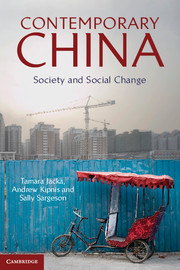Book contents
- Frontmatter
- Contents
- List of Images
- List of Maps
- List of Figures
- List of Tables
- Acknowledgments
- List of Abbreviations
- Map 0.1: China's provinces and provincial capitals
- Introduction
- Part 1 Social Institutions
- 1 Families, Kinship and Relatedness
- 2 Marriage, Intimacy and Sex
- 3 Citizenship, Household Registration and Migration
- 4 Community Institutions
- 5 Work
- Part 2 Cultures, Socialization and the Formation of Identities
- Part 3 Inequalities, Injustices and Social Responses
- Glossary of Chinese Terms
- References
- Index
2 - Marriage, Intimacy and Sex
Published online by Cambridge University Press: 05 June 2014
- Frontmatter
- Contents
- List of Images
- List of Maps
- List of Figures
- List of Tables
- Acknowledgments
- List of Abbreviations
- Map 0.1: China's provinces and provincial capitals
- Introduction
- Part 1 Social Institutions
- 1 Families, Kinship and Relatedness
- 2 Marriage, Intimacy and Sex
- 3 Citizenship, Household Registration and Migration
- 4 Community Institutions
- 5 Work
- Part 2 Cultures, Socialization and the Formation of Identities
- Part 3 Inequalities, Injustices and Social Responses
- Glossary of Chinese Terms
- References
- Index
Summary
Many westerners visiting China between the 1970s and the mid-1980s reported that it seemed one of the most sexually conservative societies in the world. Whether or not those perceptions were accurate, few western visitors today would make a similar assessment. As in any society, sexually conservative attitudes often accompany, or respond to, public expressions of sexuality in whatever form. But, in contrast to the common perception of the 1970s and 1980s, it is easy to discern a huge range of sexual views and attitudes in China today. This development reflects a number of interrelated social changes, including a rapidly accelerating shift from arranged to chosen marriage; a gradual, but cumulatively large, extension in the number of years young people spend as single adults; changes to patterns of marriage and divorce; rapid urbanization; the explosive growth of consumerism and advertising, and the use of sexual imagery in advertising; the rise of the internet and other new communications' technologies and their use in finding romance, sharing pornography and discussing sexual issues; and the growth of a large and highly visible commercial sexual services sector. This chapter discusses each of these changes.
Marriage law, shifting marital practices and premarital sex
In rural China during the first half of the 20th century, it was common for parents and matchmakers to completely arrange a marriage. The couple would not even meet one another until the wedding itself and the wedding would occur when the couple was quite young. Often, the bride was two years older than the groom, because it was thought that the bride needed to make more of an adjustment than the groom (as she would move to a new family and village) and because given the young age of the new couple (often, the groom was about 12 years old while the bride was about 14), the bride’s physical maturity, relative to her new husband’s, would enable her to bear children more quickly.
- Type
- Chapter
- Information
- Contemporary ChinaSociety and Social Change, pp. 47 - 64Publisher: Cambridge University PressPrint publication year: 2013

